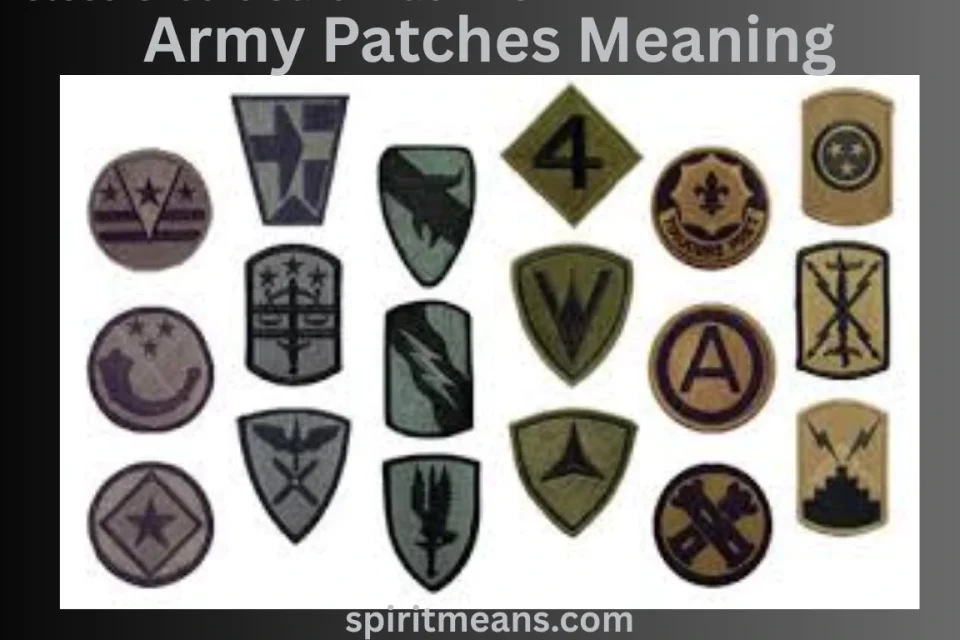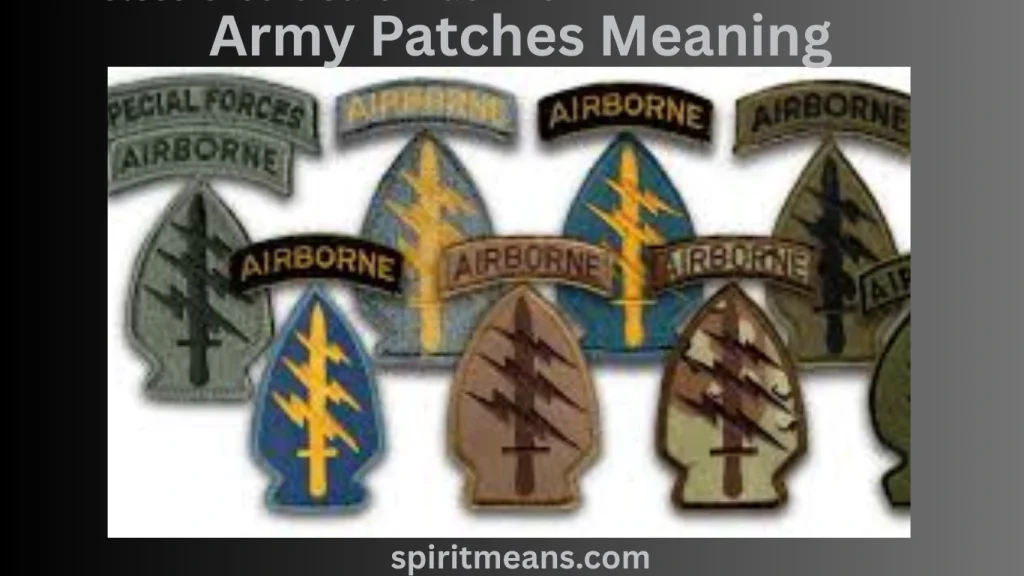Army Patches Meaning: Symbols of Service

When people ask about army patches meaning, they are not just curious about fabric. They want to know the story that cloth carries. Each patch on a uniform tells a story of identity, skill, honor, and sometimes sacrifice. For soldiers, patches are more than decoration. They are proof of who they are, where they have served, and what they achieved.
Uniforms might look simple to outsiders, but every stitch can carry pride. The placement of a patch, the symbols embroidered, and even the colors used have deep messages. If you understand them, you can read a soldier’s résumé at a glance. That is the real power of learning army patches meaning.
History of Army Patches
Patches have a long past in the U.S. Army. The first widely recognized shoulder patch came from the 81st Infantry Division during World War I. They adopted a patch with a wildcat design, which gave them the nickname “Wildcats.” At first, patches were controversial. Some thought they were unnecessary or flashy. But soon, they became a way to build identity in large forces where soldiers came from different states.
By World War II, patches were everywhere. Each division had its own design, from airborne eagles to armored tanks. They helped soldiers feel connected to their units even in distant places. Today, patches continue that legacy. They help soldiers carry history on their sleeves.
Unit Patches: Showing Current Service
The most basic patch is the unit patch on the left sleeve. It tells you the unit the soldier belongs to right now. For example, a soldier serving in the 1st Infantry Division will wear its bold red number “1.” Someone in the 10th Mountain Division wears a blue patch with crossed bayonets, symbolizing their mountain combat skills.
These unit patches mean identity. They tie a soldier to comrades around them. If you ask soldiers what their patch means, many will proudly explain their unit’s history. That is why they are so central to army patches meaning.
Combat Patches: Proof of Wartime Service
The right sleeve carries a different kind of honor. When you see a patch there, it shows the soldier deployed with that unit in combat. Known officially as the SSI-FWTS (Shoulder Sleeve Insignia – Former Wartime Service), these patches are badges of experience.
For example, if a soldier fought in Iraq with the 101st Airborne Division, they can keep wearing the “Screaming Eagle” patch on their right arm even if they later move to a new unit. It reminds them and others that they faced war.
Combat patches are emotional. Veterans often speak of the pride and sorrow they feel when seeing their combat patch. It is an unspoken way of saying, “I was there.” This is one of the most powerful parts of army patches meaning.
Flag Patches: A Symbol of Nation
You may notice that the U.S. flag looks “backward” on the right sleeve. The stars face forward, while the stripes trail behind. This is not a mistake. It is meant to show the flag moving forward into battle, never retreating. On the left sleeve, the flag appears in the normal orientation.
This detail teaches how precise the Army is about symbols. Even a flag patch carries meaning about courage and never backing down.
Skill Tabs: Recognizing Special Training
Above the shoulder patch, soldiers may wear tabs that curve like an arch. They are not separate patches but part of the system. Some of the most respected tabs are:
- Ranger Tab – earned after graduating from one of the toughest training schools.
- Airborne Tab – shows the unit is parachute-qualified.
- Special Forces Tab – identifies Green Berets.
- Mountain Tab – used by mountain warfare units.
These tabs are small, but they hold enormous weight. Soldiers often train for months or even years to earn them. Tabs add layers to army patches meaning by showing both unit identity and individual achievement.

Symbolism Inside the Designs
Each patch design is carefully chosen. Symbols are not random; they tell stories. For example, the 82nd Airborne Division uses a patch with the letters “AA,” meaning “All American.” It reflects that its soldiers come from all 48 states that existed at the time of its creation.
Some common symbols and their meanings:
- Eagle: freedom, strength, readiness.
- Sword or dagger: combat power and willingness to fight.
- Lightning bolt: speed and modern communication.
- Stars: unity, authority, or states.
- Colors: red for courage, blue for loyalty, gold for excellence, black for determination.
Learning to read these symbols is like learning a new language. It makes army patches meaning much richer.
Table of Key Patch Types
| Patch Type | Placement | Meaning |
| Unit Patch | Left Shoulder | Shows soldier’s current unit and identity |
| Combat Patch | Right Shoulder | Marks past combat service with a unit |
| Flag Patch | Both Shoulders | Symbolizes the nation, reversed on right to show advancing flag |
| Skill Tabs | Above Unit Patch | Marks special training (Ranger, Airborne, Special Forces, Mountain) |
| Morale Patch (unofficial) | Gear or off duty | Fun or humorous patches for team spirit and motivation |
Morale Patches: A Lighthearted Tradition
Not every patch is serious. Soldiers also create morale patches. These are unofficial, often funny, and used to bring laughter in tough times. They might show cartoon characters, jokes, or slogans. They are not worn on dress uniforms but can appear on gear or casual field wear.
For many, morale patches are stress relief. They turn uniforms into small reminders of humor and personality. They may not be official, but they are still part of army patches meaning in everyday life.
Emotional Weight of Patches
For civilians, patches may look like decorations. For soldiers, they can carry deep emotion. A combat patch may remind someone of lost friends. A unit patch can connect them to decades of history. A tab may remind them of the hardest training they ever faced.
Because of this, many veterans keep their patches long after leaving service. They place them in shadow boxes, on jackets, or in scrapbooks. The fabric becomes memory, and the meaning goes far beyond the Army itself.
Famous Army Patches
Some patches are so iconic that even civilians recognize them.
- 101st Airborne Division (Screaming Eagle): famous from D-Day to modern wars.
- 1st Cavalry Division (Yellow Horse): linked with armored power and Vietnam.
- 10th Mountain Division: experts in cold weather and mountain warfare.
- 82nd Airborne Division: known as “America’s Guard of Honor.”
These patches symbolize units that made history. They are living examples of army patches meaning.
Patches Across the World
The U.S. Army is not alone in using patches. Other militaries around the world use them too. British regiments have badges with crowns and lions. Russian units wear red stars. Each culture uses its own imagery, but the meaning is similar: identity, pride, and tradition.
When allied armies serve together, their patches create a visible symbol of cooperation. Soldiers often exchange patches with friends from other nations. This practice, called “trading,” is popular in international missions.
Frequently Asked Questions
What is the difference between a unit patch and a combat patch?
A unit patch shows the soldier’s current assignment. A combat patch shows service in a war zone with a past unit.
Why is the flag patch reversed on the right sleeve?
It shows the flag advancing into battle, never retreating.
Can soldiers wear more than one combat patch?
They can earn multiple, but regulations say they wear only one at a time.
Are morale patches allowed in official ceremonies?
No, they are for informal or training settings only.
Do patches have to be approved?
Yes, official patches go through Army Institute of Heraldry approval.
Conclusion
Learning army patches meaning is like unlocking a code of military history. Each patch represents identity, courage, and service. They are not random pieces of fabric. They are powerful symbols worn with pride.
From unit patches to combat patches, from flags to tabs, each design says something about the soldier. They are memories stitched into fabric. They honor the past while shaping the present.
Next time you see a soldier, look at their patches. They are telling you a story without words. By knowing their meanings, you honor their journey, their service, and their sacrifices.
Also, Read Leniency Meaning with Real Examples
